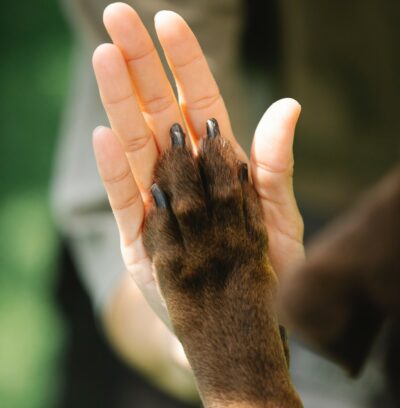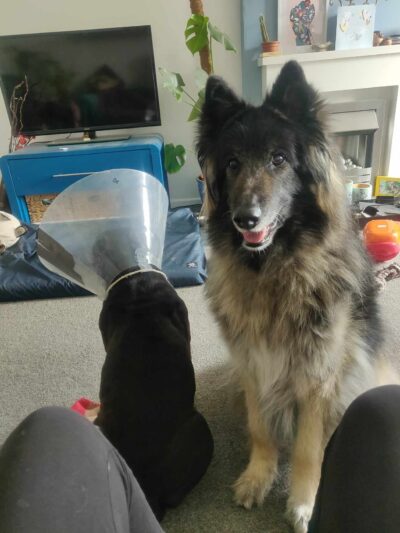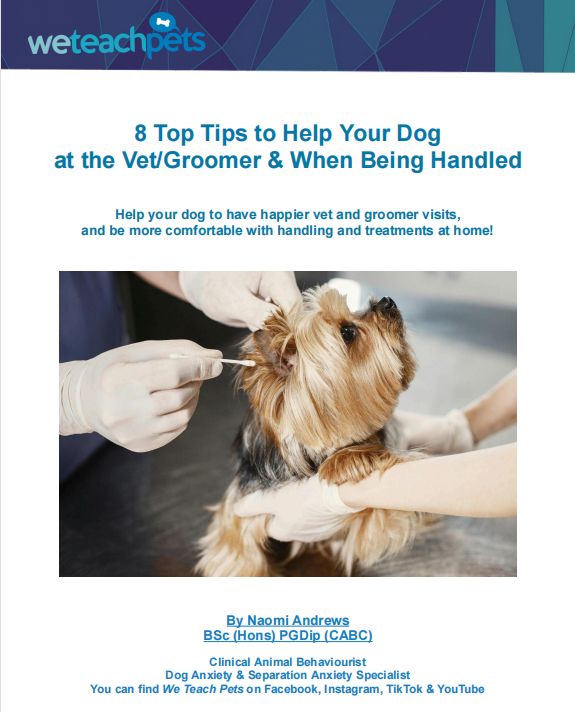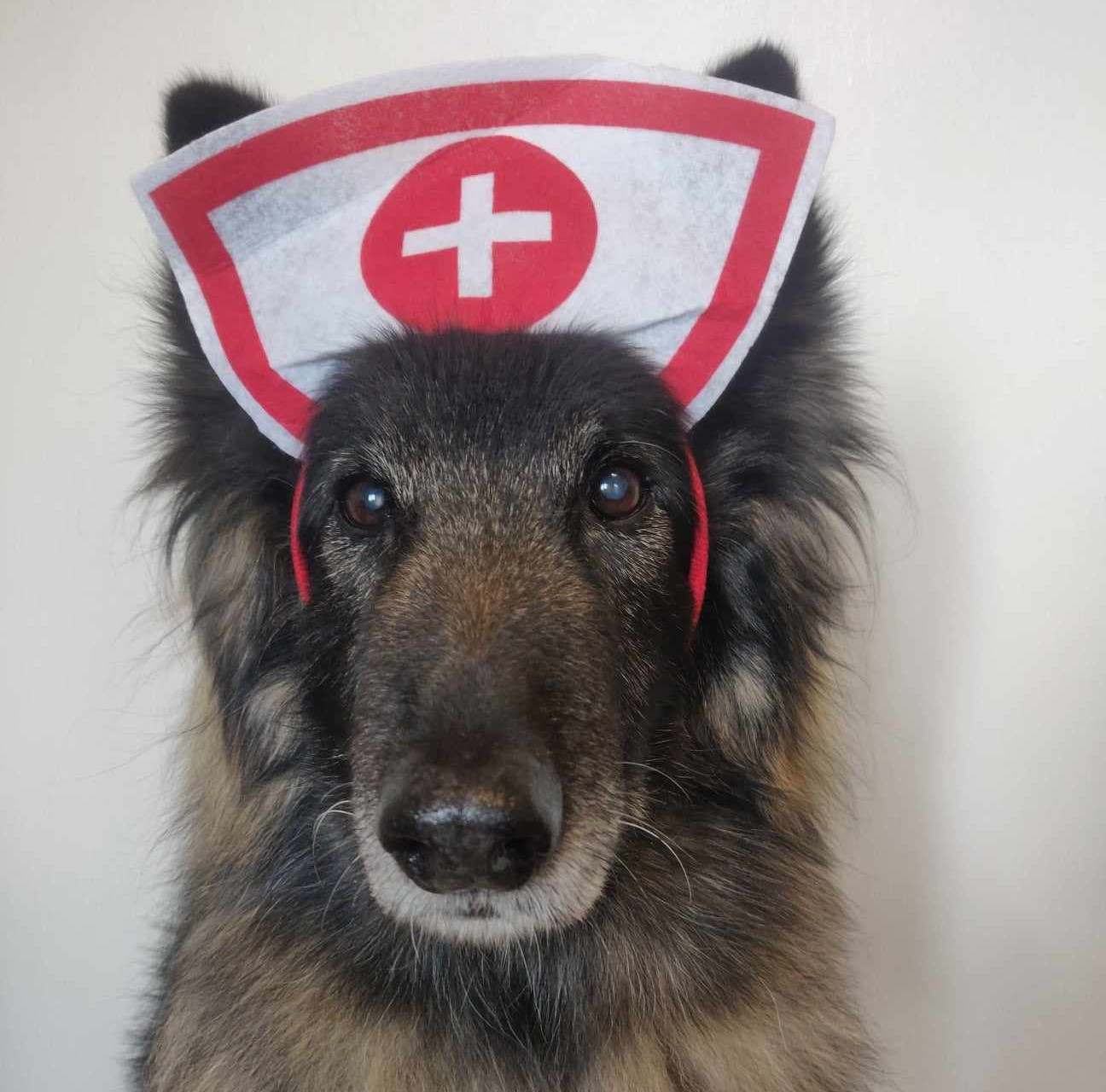Co-operative Care Dog Training
 As the name suggests, co-operative care dog training involves giving the dog choice over an interaction, usually in relation to husbandry. For example putting on a harness or lead, having flea treatments applied, nails being trimmed and so on.
As the name suggests, co-operative care dog training involves giving the dog choice over an interaction, usually in relation to husbandry. For example putting on a harness or lead, having flea treatments applied, nails being trimmed and so on.
The idea is that we introduce these things in a way that the dog can cope with, and reward them for engaging in the process. If they choose to not engage, that’s fine too!
So this training is not for emergency care where the dog is not able to opt out, though we can prepare them for some of these scenarios to help make it less stressful. For example they’ve been involved in an accident and have to have an injection at the vets to anaesthetise them, or a blood sample needs to be taken. We can prepare them for injections and blood draws, but in emergency moments you or the vet has to do what they have to do.
Cooperative care is the day to day, and the preparation for procedures in advance.
We want to take into account how our dog feels about the things that happen to them. They didn’t choose to live in our strange human world, so we have a duty to help them to cope and fit in in the most stress free way possible.
What do we mean by giving your dog choice?
When I’m teaching dogs with cooperative care techniques then I am setting up scenarios where they are able to say “no”. And, most importantly, if the dog says no, the action stops. Their no is respected.
There is, thankfully, a lot of talk about consent in human circles these days. Consent is important in our relationships with pets just like it is with other humans, whenever possible.
Being able to say no helps to build trust and mutual respect. The process helps us learn to read our dogs, attend to their needs and build secure attachments. Your dog knows they can rely on you for their emotional wellbeing. We never want our training to cause undue stress, so if you feel your dog may be stressed then cooperative care is a great option.
Signs of emotional discomfort in dogs
Some are quite obvious such as growling, snapping, or running away or hiding.
Others might be more subtle signs of stress:
When we see these signs we know that dogs are feeling uncomfortable. Some dogs are never going to love certain types of handling, but we want to reduce signs of stress as far as possible.
How can a dog say no?
 Obviously your dog cannot verbally ask you to stop doing something. But we do have things to look out for, and techniques we can use, to help build ways of communicating.
Obviously your dog cannot verbally ask you to stop doing something. But we do have things to look out for, and techniques we can use, to help build ways of communicating.
Depending on the situation we might just look for signs of stress that your particular dog is known for showing. So for example if you pick up your dog’s foot and start trimming their nails they might initially try to pull their foot away, when that doesn’t work they look away and show the whites of their eyes, then they tense up, then they lick their lips, then they begin growling.
During training if your dog shows the pre-cursers to the growling then we stop what we’re doing. This strategy teaches the dog that they don’t need to escalate to aggressive signaling.
It might be something more obvious – you can see in this picture which dog has undergone more co-operative care training. The eye drops come out and Max is facing me and ready to engage, Ernie has turned right away from me. It can be tempting, if our dogs will let us, to just hold them in place and put in the eye drops. However, your dog might try making it more and more difficult the next times you try it.
We might also look at start button behaviours. These are things we teach our dogs to do that say “OK I’m ready” or “please stop now”. For example, your dog rests their head on a chair as a “go” cue, then lifts their head as a “stop” cue.
We want our dogs to trust us, so we have to give them as many reasons as possible to do so.
If you’d like some 1-2-1 help to guide you and your dog
Sometimes it’s helpful to have someone who you can talk to about your dog’s specific struggles, to come up with a plan individually tailored for you, and someone to provide ongoing support so you know you’re getting it right and doing the right things.
If that sounds like you then I’d love to hear more about you and your dog, and your goals together.
More co-operative care content

Does your dog hate the vet? Or visiting the groomer?
This mini course looks at why your dog hates the vet, why they get in such a pickle when they visit their groomer, and how you can turn that around to achieve low stress visits for you both.
My own dog Max used to lunge, bark and snarl if the vet got anywhere near him.
I’ve created a step-by-step course which follows the strategies we used to achieve visits he now finds fun; we can both relax and get him the treatment he needs.



